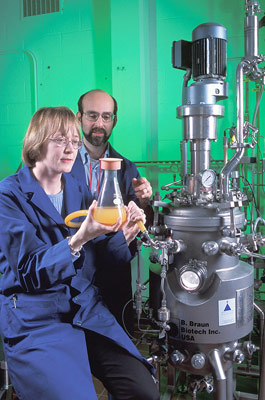Biofuels – Ethanol
Ethanol is made from biomass
Fuel ethanol is anhydrous, denatured alcohol that meets the American Society of Testing and Materials (ASTM) standard specification D4806 for ethanol use as a fuel in spark-ignition engines. Most of the fuel ethanol produced around the world is made by fermenting the sugar in the starches of grains such as corn, sorghum, and barley, and the sugar in sugar cane and sugar beets. Denaturants are added to ethanol to make fuel ethanol undrinkable. In the United States, nearly all fuel ethanol is produced from corn kernel starch, which is considered a conventional biofuel under the U.S. Renewable Fuel Standard Program (RFS).
There are other potential sources of ethanol other than fermentation of grain starch and sugars. Researchers have experimented with feedstocks including agriculture residues such as corn and rice stalks, fast-growing poplar and willow trees, grasses such as switchgrass that can produce two harvests a year for many years without annual replanting, and biomass in municipal solid waste. Trees and grasses require less fuel, fertilizers, and water to grow than grains do, and they can be grown on lands that are not suitable for growing food crops. Ethanol made from these sources is called cellulosic ethanol and is considered an advanced biofuel under the RFS. However, despite the technical potential for cellulosic ethanol production from those sources, economical production has been difficult to achieve. As of the end of 2020, there was no commercial cellulosic ethanol production in the United States. Brazil—the world’s second-largest consumer of fuel ethanol after United States—uses sugar cane to produce ethanol, which qualifies as an advanced biofuel for use in the United States under the RFS.

USDA researchers adding yeast to begin ethanol fermentation
Photo Credit: Scott Bauer, USDA Agricultural Research Service (public domain)
Ethanol is blended with gasoline
Nearly all of the motor gasoline now sold in the United States is about 10% ethanol by volume, and gasoline that is 10% ethanol by volume is called E10. Any gasoline-powered vehicle in the United States can use E10. Cars, light trucks, and medium-duty vehicles of model year 2001 and newer can use E15. Only flexible-fuel vehicles can use gasoline with ethanol content greater than 15%. E85, a fuel that contains 51%–83% ethanol, depending on location and season, is mainly sold in the Midwest and can only be used in a flexible-fuel vehicle.
Gasoline that does not contain ethanol—E0 (or ethanol-free gasoline)—may be available in some locations around the country for use in gasoline-powered tools, landscaping equipment, boats, and other equipment with gasoline engines for which E0 is recommended.
Last updated: April 7, 2022
Courtesy of EIA Gov
